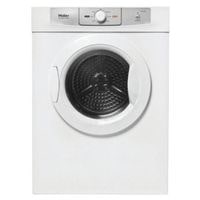Haier Dryer Not Heating. Few things are more frustrating than finding your clothes spongy after the dryer runs. Here are some common reasons why this might be happening.
First, is your dryer not heating up? It’s always useful to check if the circuit breaker has tripped, and it may also be necessary to check if there’s an obstruction causing your vent (which is the path for airflow) to get clogged.
Other potential reasons include a faulty thermal fuse and a broken heating element. If you gather your tools and follow this guide, you may be able to troubleshoot basic dryer loading problems on your own!
Haier Dryer Not Heating
We discuss some problems with Haier dryers when they do not heat up here.
Issue With Timer
If you find that your dryer isn’t heating, one of the first parts to check is the timer. However, this is usually not the problem. Before tossing out the timer, make sure to replace any other components that are known to fail often.
Test your wiring diagram to ensure all the electrical parts are working properly and if they are, then it’s likely that your timer has gone bad. Replace any failed timers with new electronic timers.
Problem With Cycling Thermostat
If your dryer is not heating, check the cycling thermostat, as it controls the heat in your dryer. The cycling thermostat allows you to set a low and high temp.
However, most will also have an auto-dry function that cycles the heater on and off to maintain the temperature selected.
Before replacing a faulty cycling heat thermostat with a new one, be sure to check all other parts that are much more commonly defective and replace them if found defective first.
Testing the existing cycling heat thermostat is easy; use a multimeter to test for electrical continuity when testing. After doing this test, replace whatever part is not reacting positively.
Thermostat With High Limit
The high limit thermostat measures the dryer temperature and then turns off the burner if the temperatures rise past a certain point.
If the high limit thermostat is faulty, it may shut off the burner even in cases when there is no issue with overheating.
However, this seldom occurs. Before replacing the high limit thermostat, check out all the other more commonly defective parts.
In case it has been ascertained that all components work as intended, test for continuity by using a multimeter to make sure that key components are not defective. If so, then replace them immediately.
Cause Of Heating Element
The heating element is inside the dryer and heats up the air sent into the drum. Over time, this heating element will wear out and break, which is why you need to replace it when that happens so that your dryer can continue heating normally again.
The best way to tell if the heating element has suffered from enough wear over time is by using a multimeter to check for continuity as this will detect metallic resistance in an electrical circuit.
When there’s continuity in an electrical current without interruption or loss of current flow, then this means that firmly connected conductors allow electrons to flow freely through a circuit.
Error In Flame Sensor
A gas dryer’s flame sensor detects the heat emitted from the appliance’s flame. If a leak happens, the flame sensor will stop working and the dryer will stop heating.
Before you check for an error code and replace the flame sensor, make sure that there are no faults with either the igniter or thermal fuse.
The thermal fuse is automatic; it shuts off electrical power if overheating causes damage to another part of the dryer because this indicates a fire danger.
Solenoid For Gas Valves
Gas dryers contain two or more solenoid coils that open the gas valve ports to allow gas to flow into their burner assembly.
If one of these coils fails, the gas cannot enter the system and the resulting lack of pressure prevents ignition.
In order to determine if one of these coils has been damaged, it’s important to first check your igniter which will show whether or not ignition occurred.
If no ignition occurred and your igniter glows for a brief moment but goes out before successfully lighting your dryer’s burner, then you likely have a defective solenoid coil causing your dryer malfunction.
Defective Thermal Fuse
A thermal fuse is part of a safety device in dryers that will cut power to the dryer if it gets too hot which can lead to a dangerous fire or even a house fire.
If it has blown, there will be no power flow through the fuse when testing for continuity with a multimeter, meaning it has broken and does not work.
Always check the vent from your dryer to outside of your home when replacing the thermal fuse because you want to make sure that either lint or fabric hasn’t clogged up this safety feature from being able to work properly.
Related Guides
